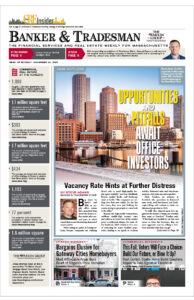Jonathan Garland
President and founder, J. Garland Enterprises
Age: 43
Industry experience: 25 years
Jonathan Garland combines architecture and development services under the umbrella of J. Garland Enterprises, his Boston-based company, while offering guidance to other developers in his civic role as a member of the Boston Civic Design Commission. JGE Architecture + Design provides architectural services for projects such as the Animal Rescue League of Boston’s new care and adoption center, currently under construction in South End.
Garland’s JGE Development arm specializes in turning underutilized real estate into new market-rate and income-restricted housing. The firm is partnering with the Planning Office of Urban Affairs on a mixed-income development at 175 Ruggles St. in Roxbury, which was made available by the city of Boston through a surplus property disposition. Garland has 25 years of experience in architecture, including a previous role as director of design at Boston-based DREAM Collaborative.
Q: What was your business plan for JGE Enterprises and how is it evolving?
A: We launched in 2018 and it has been a great ride. I often tell people my personal feeling about it as a small business: It’s the hardest I’ve ever worked, but it’s the most fun I’ve ever had. With respect to the business model, it was always thought to be an enterprise. That’s baked into the name, with JGE under that and JGE Development. We wanted to approach the marketplace with a dual platform and be able to provide a level of service doing good design work but building with community, where we can be part of the community discussions and really building concepts around multifamily affordable housing with strategic community benefits that have come from the community, rather than saying, “Here’s what we’re here to provide you.” That level of transparency and honesty we’ve seen come back with happy neighbors and clients and city officials.
Q: How do you approach the community benefits conversation differently?
A: Normally, you might hear things about providing a community room or a brand new residence for a blighted lot. But when you get to talking to residents, often single parents, what they are asking is: Is there anything you can do with respect to my son’s or daughter’s college fund? Is there a college fund you put together? Are there computer literacy classes or first-time homebuyers classes? It’s less about the bricks and mortar and more about the plugging the gaps of access points they can’t get to.
We’re co-developing Drexel Village with the Planning Office of Urban Affairs, and it has not just housing. It has multigenerational open space, with public art as a core component. There’s nonprofit commercial space that we’re going to provide. That is all a complement to the restricted affordable housing to the tune of 117 units.
Those amenities would not have come about without conversations with the neighbors. One mother spoke to us and said, “When you guys do these developments, it would be nice to think about the life of an adolescent. What are you doing to provide safe places afterschool?” That gave birth to a teen afterschool lounge on the ground floor. The purpose is to have teens in some spaces where there is some degree of supervision and oversight. We are looking toward 2027 [for groundbreaking] and we’re currently working through funding awards for subsidies.
Q: What effects do you expect the PLAN: Downtown rezoning would have on development and adaptive reuse projects?
A: I’m hoping it will spark more development. As a city at large, we need more cranes in the air. A lot of us remember the days when the Seaport was booming, not long ago. There’re also linkage fees that trickle into the affordable housing coffers, and we desperately need that. That’s when the whole ecosystem is working properly. PLAN: Downtown could mean more height. Boston is a unique city where people pay attention. People lean in. Part of our role on the Boston Civic Design Commission is to be the eyes and ears of the city, making sure that it does a good job in protecting its public spaces, civic spaces, looking at shadows, massing designs, traffic. Developers should look at this new PLAN: Downtown to offer a plethora of opportunities, and it will be up to [bodies] like the BCDC to come up with something that works throughout the neighborhood.
Q: What are your impressions of the Article 80 zoning changes in Boston?
A: I’m encouraged that it will help a lot. At the core of both the BCDC changes and Article 80 reform there’s this common thread around predictability: making sure that everybody, no matter their walk of life, or understanding how development works, can successfully navigate the process. Success really means clarity of process, not approval. There’s a lot of ambiguity and sometimes it looks like politics are at play. I’m hopeful it will help developers understand from a risk assessment profile: What’s the likelihood of getting out of the permitting process in an efficient way? Are the city officials working with me, or am I bearing all the brunt of the risk myself? It will be up to the private sector and the agencies to work together. We were able to talk to [Boston Planning Department] Director Kairos Shen and he seemed open that we could at least pilot some of these initiatives before everything is formally memorialized.
Q: Does the city still need to streamline the Inspectional Services Department process to make it more efficient?
A: It definitely could use some improvement. The [online] portal is helpful in the sense that you don’t need to come down to the counter to speak to someone. I definitely support the modernization in terms of the permitting. I’m hoping they will look at a larger reform. It’s an opportunity to almost purge the closet and look at some of the antiquated rule sets and guidelines and say: “What do we know now about technology and the way people are constructing buildings and development timelines that we can bring to bear to improve the system?” Without doing that comprehensive reform, it may feel like we’re just doing some cosmetic improvements out there.
Q: In your development role, what’s the decision tree when looking at whether to design for rentals or homeownership units?
A: I definitely support the city councilors and folks at the mayor’s office and other outspoken leaders voicing the desire for home ownership. I know it’s a direct call from their constituents. The problem we’re running into is the [public] programs for home ownership don’t exist. It’s gotten to the point where they’ve awarded to some projects and had to rescind some awards.
It’s an issue with financing the market rate units and getting the numbers to work. There is a premium on the home ownership units with respect to amenities and the need for off-street parking. You’re asking somebody to buy a condominium and sign a purchase-and-sale for 30-plus years. At that point, you’re thinking about the life cycle of an individual or a family, and it comes with a little bit more of an expensive build. Banks and lenders have to work more closely with policymakers.
We’re thankful to be co-developers on the Parker and Terrace in Mission Hill, which is probably the last affordable housing homeownership projects in Boston that will make it through the CommonWealth Builder fund allocation. That’s 48 brand-new Passive House affordable homeownership units, so we’re excited for that.
But there have been cuts at the federal level which affect the state, and a big downturn in larger-scale developments, so a lot of the linkage fees these agencies would pull from are just not available at this point. Everybody’s kind of hunkering down because at the federal level, we don’t know what’s going to get cut next. These things have a ripple effect. The Section 8 vouchers have been slashed. We’re trying to put pro formas together, but it’s hard when you have a capital stack of eight sources and two of them just dropped out.
Garland’s Five Favorite Breakfast Spots:
- Henrietta’s Table, Harvard Square
- The Original Pancake House (outside of Massachusetts)
- The Farmer’s Daughter, Easton
- North Street Grille, North End
- Mike’s City Diner, South End






